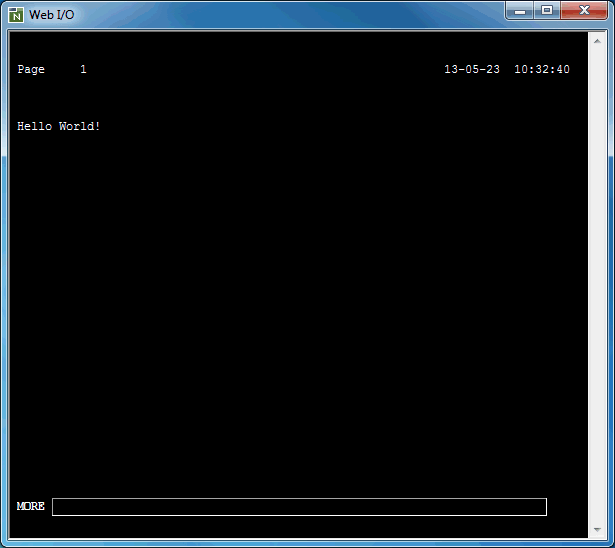The Natural Web I/O Interface client is used in a remote development environment to display non-GUI information which contains Unicode characters. This is different from the local environment where the output is shown in an output window.
This document covers the following topics:
See also Differences between Natural Web I/O Interface Client and Terminal Emulation in the Natural Web I/O Interface documentation.
When specific parameters have been set on the Natural Development Server (see below), the Natural Web I/O Interface client is used instead of the terminal emulation window (which is not Unicode-enabled).
The following example shows a Natural Web I/O Interface client containing the output of a program that has been executed in a remote environment.

The Natural Web I/O Interface client enables you to test a complete
application, including all of its character output, without having to leave
Natural Studio. A screen output of an executed program automatically causes the
Natural Web I/O Interface client to be opened and to be closed again when the
program terminates (logically, the development server session reaches the
NEXT level).
Utilities for which Natural Studio does not offer a graphical user interface in the remote environment are also made available by the Natural Web I/O Interface client. Entering the corresponding system command in Natural Studio's command line automatically opens a Natural Web I/O Interface client.
When you close the Natural Web I/O Interface client manually, this corresponds to pressing ESC in the application.
So that the Natural Web I/O Interface client can be invoked, the Natural Development Server (NDV) has to be configured as follows:
UNIX
If you want to use the Natural Web I/O Interface client in a
remote UNIX environment, the profile parameter WEBIO
must be set to ON on the NDV server. See Configuration
Utility in the Natural for UNIX documentation.
Mainframe
If you want to use the Natural Web I/O Interface client in a
remote mainframe environment, the NDV configuration parameter
TERMINAL_EMULATION must be set to WEBIO on
the NDV server. See NDV Configuration Parameters in the
corresponding Natural Development Server documentation. Moreover, the Web I/O
terminal converter module NATWEB must be linked to the Natural
nucleus. The Natural profile parameter TMODEL can be
used to determine the user screen size.
Windows
In a remote Windows environment, the Natural Web I/O Interface
client is always used, regardless of the setting of the profile parameter
WEBIO.
When the Natural output is shown in the Natural Web I/O Interface client, any defined PF keys are shown as buttons in the window (instead of the key prompting lines which are normally shown in the native UNIX or mainframe environment). You can either use these buttons or you can press the corresponding keys on your keyboard (for example, F5 for PF5).
Note:
A refresh function is not executed when you press
F5.
You can enter your input as usual. You can also use the usual Windows copy-and-paste functionality.
In the Natural Web I/O Interface client, the color attributes for the Natural fields (foreground colors), the background color, and the rendering of the Natural field attributes are controlled using an XSLT file. The name of this XSLT file is natunistyle.xsl. After the installation of Natural for Windows, this file can be found in the \Program Files (x86)\Common Files\Natural\V1\bin folder.
The following topics are covered below:
The foreground colors for the font are mapped in the following section of the XSLT file:
<!-- Map foreground colors -->
<xsl:variable name="forecol">
<xsl:choose>
<xsl:when test="@forecol='Red'">red</xsl:when>
<xsl:when test="@forecol='Green'">LimeGreen</xsl:when>
<xsl:when test="@forecol='Blue'">DodgerBlue</xsl:when>
<xsl:when test="@forecol='White'">white</xsl:when>
<xsl:when test="@forecol='Pink'">fuchsia</xsl:when>
<xsl:when test="@forecol='Turquoise'">aqua</xsl:when>
<xsl:when test="@forecol='Yellow'">yellow</xsl:when>
<xsl:when test="@forecol='Black'">white</xsl:when>
<xsl:when test="@forecol='Transparent'">
<xsl:choose>
<xsl:when test="@intensified='True'">aqua</xsl:when>
<xsl:otherwise><xsl:value-of select="$defforecolor"/></xsl:otherwise>
</xsl:choose>
</xsl:when>
<xsl:otherwise><xsl:value-of select="$defforecolor"/></xsl:otherwise>
</xsl:choose>
</xsl:variable>
For example, the color attribute
Red of the Natural screen is mapped to the CSS
color "red":
<xsl:when test="@forecol='Red'">red</xsl:when>
It is also possible to map the color attributes to RGB values. For example:
<xsl:when test="@forecol='Red'">#FF0000</xsl:when>
For the color attribute
Transparent, it is checked whether the attribute
intensified is set. If this is true, the color
"aqua" is used. If not, the global variable
$defforecolor, which is defined at the beginning
of the XSLT file, is used.
More information on CSS colors can be found in the internet under https://www.w3schools.com/cssref/css_colors.asp.
The background color is set with the global variable
defbackcolor, which is defined at the beginning of
the XSLT file.
<!-- Background color --> <xsl:variable name="defbackcolor" select="'black'"/>
The field attribute for reverse video is set in the following section of the XSLT file, which occurs directly after the section in which the foreground colors are mapped:
<!-- START SET FOREGROUND AND BACKGROUND COLORS FOR REVERSE ATTRIBUTE -->
<!-- Set foreground colors -->
<xsl:variable name="ForeCol">
<xsl:choose>
<xsl:when test="@reverse='True'">color:<xsl:value-of select="$defbackcolor"/></xsl:when>
<xsl:otherwise>color:<xsl:value-of select="$forecol"/></xsl:otherwise>
</xsl:choose>
</xsl:variable>
<!-- Set background colors -->
<xsl:variable name="BackCol">
<xsl:choose>
<xsl:when test="@reverse='True'">background-color:<xsl:value-of select="$forecol"/></xsl:when>
<xsl:otherwise>background-color:<xsl:value-of select="$defbackcolor"/></xsl:otherwise>
</xsl:choose>
</xsl:variable>
<!-- END SET FOREGROUND AND BACKGROUND COLORS FOR REVERSE ATTRIBUTE -->
When the reverse attribute is set
to true, the foreground color is set to the value of
$defbackcolor and the background color gets the
value of the foreground color.
When the reverse attribute is not
set to true, the foreground color gets the value of the mapped foreground color
and the background color gets the value of
$defbackcolor.
The field attributes for underlined and blinking text are set in the following section of the XSLT file:
<!-- Set underline and blinking attributes -->
<xsl:variable name="TextDecoStyle">
<xsl:choose>
<xsl:when test="@underline='True'">text-decoration:underline;</xsl:when>
<xsl:when test="@blinking='True'">text-decoration:blink;</xsl:when>
<xsl:otherwise>text-decoration:normal;</xsl:otherwise>
</xsl:choose>
</xsl:variable>
Since the Natural Web I/O Interface client uses the Internet Explorer which does not support blinking text, blinking text will not be displayed in the browser window.
The field attribute for cursive/italic text is set in the following section of the XSLT file:
<!-- Set cursive attribute -->
<xsl:variable name="FontStyle">
<xsl:choose>
<xsl:when test="@italic='True'">font-style:italic;</xsl:when>
<xsl:otherwise>font-style:normal;</xsl:otherwise>
</xsl:choose>
</xsl:variable>
The field attribute for intensified text is set in the following section of the XSLT file:
<!-- Set intensified attribute - draw text as bold -->
<xsl:variable name="FontWeight">
<xsl:choose>
<xsl:when test="@intensified='True'">font-weight:bolder</xsl:when>
<xsl:otherwise>font-weight:normal;</xsl:otherwise>
</xsl:choose>
</xsl:variable>